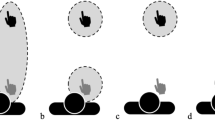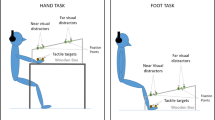Abstract
The previous studies have shown the importance of body in the visuo-spatial representation of space and the objects in it. Perception of objects located near the body trigger activations in brain regions involved in making voluntary movements. Such activations are restricted to the peripersonal space (PPS) particularly within a certain distance of the hand and are considered the visual receptive field of this space. Behavioral findings have shown reduced response time and enhanced accuracy for targets presented in the peri-hand space, referred to as the peri-hand effect. There has been considerable debate about the nature of these effects with some researchers arguing that it is attentional and others arguing that it is perceptual. In the current review, we summarize research about the PPS with a special focus on the peri-hand space and changes to visuo-spatial processing associated with objects places in this space. We suggest that there is enough evidence in the literature pointing at independent and dissociable perceptual and attentional effects in the peri-hand space. We also highlight the differences in the spatial extent of these effects for perception and attention. We propose that future studies looking at the peri-hand effects should dissociate these effects to better understand the nature of visual processing occurring in the peri-hand space.
Similar content being viewed by others
References
Johannsen K, De Ruiter JP (2013) The role of scene type and priming in the processing and selection of a spatial frame of reference. Front Psychol 4:182
Tower-Richardi SM, Brunyé TT, Gagnon SA, Mahoney CR, Taylor HA (2012) Abstract spatial concept priming dynamically influences real-world actions. Front Psychol 3:361
Dijkstra K, Eerland A, Zijlmans J, Post LS (2012) How body balance influences political party evaluations: a wii balance board study. Front Psychol 3:536
Gibson JJ (1979) The ecological approach to visual perception. Houghton Mifflin, Boston
Chao LL, Martin A (2000) Representation of manipulable man-made objects in the dorsal stream. Neuroimage 12:478–484
Grafton ST, Fadiga L, Arbib MA, Rizzolatti G (1997) Premotor cortex activation during observation and naming of familiar tools. Neuroimage 6:231–236
Jeannerod M, Arbib MA, Rizzolatti G, Sakata H (1995) Grasping objects: the cortical mechanisms of visuomotor transformation. Trends Neurosci 18:314–320
Tucker M, Ellis R (1998) On the relations between seen objects and components of potential actions. J Exp Psychol Hum Percept Perform 24:830–846
Tucker M, Ellis R (2001) The potentiation of grasp types during visual object categorization. Vis Cogn 8:769–800
Graziano MSA, Cooke DF (2006) Parieto-frontal interactions, personal space, and defensive behavior. Neuropsychologia 44(13):2621–2635
Graziano MSA, Gross CG, Taylor CSR, Moore T (2012) A system of multimodal areas in the primate brain. In: Spence C, Driver J (eds) Crossmodal space and crossmodal attention. Oxford University Press, United Kingdom, pp 51–67
Rizzolatti G, Scandolara C, Matelli M, Gentilucci M (1981) Afferent properties of periarcuate neurons in macaque monkeys. II. Visual responses. Behav Brain Res 2:147–163
Makin TR, Holmes NP, Zohary E (2007) Is That Near My Hand? Multisensory representation of peripersonal space in human intraparietal sulcus. J Neurosci 27:731–740
Brozzoli C, Gentile G, Petkova VI, Ehrsson HH (2011) FMRI adaptation reveals a cortical mechanism for the coding of space near the hand. J Neurosci 31:9023–9031
Làdavas E, di Pellegrino G, Farnè A, Zeloni G (1998) Neuropsychological evidence of an integrated visuotactile representation of peripersonal space in humans. J Cogn Neurosci 10:581–589
Spence C, Pavani F, Maravita A, Holmes N (2004) Multisensory contributions to the 3-D representation of visuotactile peripersonal space in humans: evidence from the crossmodal congruency task. J Physiol Paris 98:171–189
Reed CL, Grubb JD, Steele C (2006) Hands up: attentional prioritization of space near the hand. J Exp Psychol Hum Percept Perform 32:166–177
Reed CL, Betz R, Garza JP, Roberts RJ (2010) Grab it! Biased attention in functional hand and tool space. Atten Percept Psychophys 72:236–245
Tseng P, Bridgeman B (2011) Improved change detection with nearby hands. Exp Brain Res 209:257–269
Dufour A, Touzalin P (2008) Improved visual sensitivity in the perihand space. Exp Brain Res 190(1):91–98
Abrams R, Davoli CC, Du F, Knapp WH, Paull D (2008) Altered vision near the hands. Cognition 107:1035–1047
Cosman JD, Vecera SP (2010) Attention affects visual perceptual processing near the hand. Psychol Sci 21:1254–1258
Gozli DG, West GL, Pratt J (2012) Hand position alters vision by biasing processing through different visual pathways. Cognition 124:244–250
Fogassi L et al (1996) Coding of peripersonal space in inferior premotor cortex (area F4). J Neurophysiol 76:141–157
Macaluso E, Maravita A (2010) The representation of space near the body through touch and vision. Neuropsychologia 48:782–795
Serino A et al (2015) Body part-centered and full body-centered peripersonal space representations. Sci Rep. 5:18603
Brozzoli C, Ehrsson HH, Farnè A (2014) Multisensory representation of the space near the hand: from perception to action and interindividual interactions. Neuroscientist 20:122–135
Noel JP et al (2015) Full body action remapping of peripersonal space: the case of walking. Neuropsychologia 70:375–384
Kandula M, Hofman D, Dijkerman HC (2015) Visuo-tactile interactions are dependent on the predictive value of the visual stimulus. Neuropsychologia 70:358–366
Graziano M, Yap G, Gross C (1994) Coding of visual space by premotor neurons. Science 266:1054–1057
Hyvarinen J, Poranen A (1974) Function of the parietal associative area 7 as revealed from cellular discharges in alert monkeys. Brain 97:673–692
Rizzolatti G, Matelli M, Pavesi G (1983) Deficits in attention and movement following the removal of postarcuate (Area-6) and prearcuate (Area-8) cortex in Macaque Monkeys. Brain 106:655–673
Latto R, Cowey A (1971) Fixation changes after frontal eye-field lesions in monkeys. Brain Res 30:25–36
Gross CG, Graziano MSA (1995) Multiple representations of space in the brain. Neurosci 1:43–50
Avillac M, Ben Hamed S, Duhamel J-R (2007) Multisensory integration in the ventral intraparietal area of the Macaque Monkey. J Neurosci 27:1922–1932
Bremmer F, Schlack A, Duhamel J-R, Graf W, Fink GR (2001) Space coding in primate posterior parietal cortex. Neuroimage 14:S46–S51
Duhamel JR, Colby CL, Goldberg ME (1998) Ventral intraparietal area of the macaque: congruent visual and somatic response properties. J Neurophysiol 79:126–136
Schlack A (2005) Multisensory space representations in the macaque ventral intraparietal area. J Neurosci 25:4616–4625
Leinonen L, Hyvärinen J, Nyman G, Linnankoski II (1979) Functional properties of neurons in lateral part of associative area 7 in awake monkeys. Exp Brain Res 34:299–320
Leinonen L, Nyman G II (1979) Functional properties of cells in anterolateral part of area 7 associative face area of awake monkeys. Exp Brain Res 34:321–333
Hyvärinen J (1981) Regional distribution of functions in parietal association area 7 of the monkey. Brain Res 206:287–303
Jiang H-H, Hu Y-Z, Wang J-H, Ma Y-Y, Hu X-T (2013) Visuospatial properties of caudal area 7b in Macaca fascicularis. Zool Res. 34:E50–E61
Duhamel J-RR, Bremmer F, Ben Hamed S, Graf W (1997) Spatial invariance of visual receptive fields in parietal cortex neurons. Nature 389:845–848
Berti A, Frassinetti F (2000) When far becomes near: remapping of space by tool use. J Cogn Neurosci 12:415–420
Cowey A, Small M, Ellis S (1994) Left visuo-spatial neglect can be worse in far than in near space. Neuropsychologia 32:1059–1066
Cowey A, Small M, Ellis S (1998) No abrupt change in visual hemineglect from near to far space. Neuropsychologia 37:1–6
Halligan PW, Marshall JC (1991) Left neglect for near but not far space in man. Nature 350:498–500
Pitzalis S, Di Russo F, Spinelli D, Zoccolotti P (2001) Influence of the radial and vertical dimensions on lateral neglect. Exp Brain Res 136:281–294
Vuilleumier P, Valenza N, Mayer E, Reverdin A, Landis T (1998) Near and far visual space in unilateral neglect. Ann Neurol 43:406–410
Aimola L, Schindler I, Simone AM, Venneri A (2012) Near and far space neglect: task sensitivity and anatomical substrates. Neuropsychologia 50:1115–1123
Colby CL, Duhamel JR, Goldberg ME (1993) Ventral intraparietal area of the macaque: anatomic location and visual response properties. J Neurophysiol 69:902–914
Gentilucci M et al (1988) Functional organization of inferior area 6 in the macaque monkey-I. Somatotopy and the control of proximal movements. Exp Brain Res 71:475–490
Brockmole JR, Davoli CC, Abrams R, Witt JK (2013) The world within reach: effects of hand posture and tool use on visual cognition. Curr Dir Psychol Sci 22:38–44
Posner MI, Cohen Y (1984) Components of visual orienting. Atten Perform Control Lang Process 32:531–556
Davoli CC, Brockmole JR, Du F, Abrams RA (2012) Switching between global and local scopes of attention is resisted near the hands. Visual Cognition 20(6):659–668
Julesz B (1984) A brief outline of the texton theory of human vision. Trends Neurosci 7:41–45
Kimchi R, Peterson MA (2008) Figure-ground segmentation can occur without attention. Psychol Sci J Am Psychol Soc. 19:660–668
Maunsell JH et al (1999) Visual response latencies of magnocellular and parvocellular LGN neurons in macaque monkeys. Vis Neurosci 16:1–14
Pokorny J, Smith V (1997) Psychophysical signatures associated with magnocellular and parvocellular pathway contrast gain. J Opt Soc Am A 15:2440–2442
Derrington AM, Lennie P (1984) Spatial and temporal contrast sensitivities of neurones in lateral geniculate nucleus of macaque. J Physiol 357:219–240
Livingstone M, Hubel D (1988) Segregation of form, color, movement, and depth: anatomy, physiology, and perception. Science 240:740–749
Kelly SP, Brockmole JR (2014) Hand proximity differentially affects visual working memory for color and orientation in a binding task. Front Psychol 5:318
Suh J, Abrams RA (2015) Reduced object-based perception in the near-hand space. Exp Brain Res 233:3403–3412
Taylor JET, Gozli DG, Chan D, Hufman G, Pratt J (2015) A touchy subject: advancing the modulated visual pathways account of altered vision near the hand. Transl Neurosci 6:1–7
Reed CL, Leland DS, Brekke B, Hartley AA (2013) Attention’s grasp: early and late hand proximity effects on visual evoked potentials. Front Psychol 4:420
Thomas T, Sunny MM (2017) Acta psychologica slower attentional disengagement but faster perceptual processing near the hand. Acta Psychol (Amst) 174:40–47
Milner AD, Goodale MA (1998) The visual brain in action. In: Bourget D, Chalmers D (eds). Oxford University Press, Scotland, p 248
Coello Y, Bourgeois J, Iachini T (2012) Embodied perception of reachable space: how do we manage threatening objects? Cogn Process 13(Suppl 1):S131–S135
Graziano MSA, Cooke DF (2006) Parieto-frontal interactions, personal space, and defensive behavior. Neuropsychologia 44:2621–2635. https://doi.org/10.1016/j.neuropsychologia.2005.09.009
Holmes NP, Spence C (2004) The body schema and multisensory representation(s) of peripersonal space. Cogn Process 5:94–105
Tajadura-Jiménez A, Pantelidou G, Rebacz P, Västfjäll D, Tsakiris M (2011) I-space: the effects of emotional valence and source of music on interpersonal distance. PLoS One 6(10):e26083
Canzoneri E, Magosso E, Serino A (2012) Dynamic sounds capture the boundaries of peripersonal space representation in humans. PLoS One 7(9):e44306
Taffou M, Viaud-Delmon I (2014) Cynophobic fear adaptively extends peri-personal space. Front Psychiatry 5:3–9
Gray R, Tan HZ (2002) Dynamic and predictive links between touch and vision. Exp Brain Res 145:50–55
Cléry J, Guipponi O, Wardak C, Ben Hamed S (2015) Neuronal bases of peripersonal and extrapersonal spaces, their plasticity and their dynamics: knowns and unknowns. Neuropsychologia 70:313–326
Author information
Authors and Affiliations
Corresponding author
Rights and permissions
About this article
Cite this article
Thomas, T., Sunny, M.M. Altered Visuo-spatial Processing in the Peri-personal Space: A New Look at the Hand-Proximity Effects. J Indian Inst Sci 97, 443–450 (2017). https://doi.org/10.1007/s41745-017-0057-x
Received:
Accepted:
Published:
Issue Date:
DOI: https://doi.org/10.1007/s41745-017-0057-x




